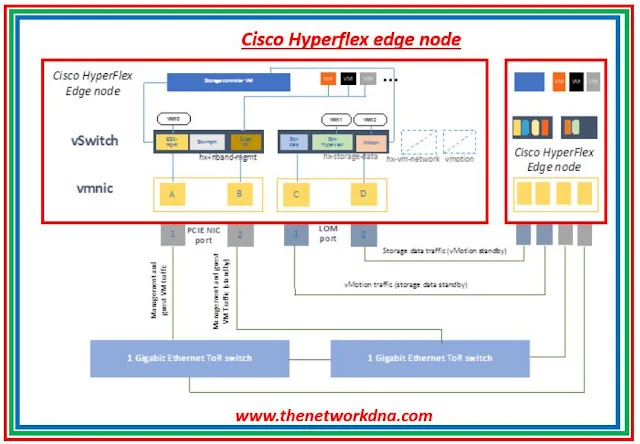10 Interview questions on Cisco Hyperflex
10 Interview questions on Cisco Hyperflex
Today we are going to talk about the basic few questions which are usually asked in the interview for Cisco Hyperflex
Let's start with the first part of interview questions in Cisco Hyperflex. we will come up with another round of questions in Cisco Hyperflex.
 |
| Fig 1.1- Cisco Hyperflex |
What is Cisco Hyperflex and what are its benefits?
Cisco Hyperflex is an HCI solution that combines computing, network, storage, and HCI software into a single system. It enables organizations to deploy applications from the core to the edge and across many clouds, with easier installation and maintenance, smaller storage footprints, lower latency, and improved performance.
How does Cisco Hyperflex differ from other HCI solutions?
Cisco Hyperflex is built on the Cisco Unified Computing System (UCS) platform, which offers convergent compute and networking capabilities, as well as the HX Data Platform, a distributed file system that optimizes data management and performance. Cisco Hyperflex also facilitates multicloud development and deployment of cloud-native apps, as well as extending the ease of use of Hyperconvergence to the edge on a distributed scale.
What are some use cases for Cisco Hyperflex?
In your data center, Cisco Hyperflex can power mission-critical applications and databases such as SAP HANA, Oracle, Microsoft SQL Server, VMware Horizon, and Citrix Virtual Apps and Desktops. It may also support multicloud development and deployment of cloud-native apps through the use of Kubernetes and Docker containers. It can also enable edge computing situations including retail, healthcare, manufacturing, and smart cities.
How does Cisco Hyperflex ensure data protection and security?
Cisco Hyperflex ensures data protection and security in several ways:
- It employs self-encrypting drives (SEDs), which enable encryption without sacrificing performance.
- It works with enterprise key management solutions to safeguard encryption keys.
- It allows for data-at-rest encryption throughout the whole HyperFlex cluster by utilizing authentication keys (AKs).
- It provides a straightforward interface for configuring and managing data security settings.
How does Cisco HyperFlex provide scalability?
What is the HyperFlex Data Platform?
- Deduplication and compression of data to minimize storage footprint and increase efficiency
- Snapshots and clones allow for quick and efficient backups and restorations.
- To safeguard data across locations and regions, native replication and disaster recovery are used.
- Caching and dynamic data placement to improve performance and robustness
- Management and orchestration are simplified by integration with Cisco Intersight, VMware vSphere, Microsoft Hyper-V, Kubernetes, and other systems.
What are the key benefits of using HyperFlex for virtual desktop infrastructure (VDI)?
What is the difference between HyperFlex HX-Series and HyperFlex Edge?
- The HyperFlex HX-Series is intended for use in data centers, whilst the HyperFlex Edge is intended for use in remote and branch office installations.
- The HyperFlex HX-Series has a wide range of node types and capabilities, but the HyperFlex Edge has fewer node possibilities.
- The HyperFlex HX-Series requires at least three nodes per cluster, however the HyperFlex Edge may operate with as little as two nodes per cluster.
- HyperFlex HX-Series clusters may have up to 64 nodes, whereas HyperFlex Edge clusters can have up to four nodes.
- Cisco Intersight or Cisco UCS Manager can manage the HyperFlex HX-Series, however only Cisco Intersight can handle the HyperFlex Edge.
What is the role of Cisco Intersight in HyperFlex management?
What is the difference between Cisco Hyperflex and NetApp HCI?
NetApp HCI and Cisco Hyperflex are both hyperconverged infrastructure (HCI) technologies that combine computing, storage, and networking into a single system. They do, however, differ in terms of functionality, performance, and architecture.
Cisco Hyperflex's features include easier deployment and configuration, flexible and scalable resources, and support for multicloud and edge scenarios. NetApp HCI enables flexible and granular resource allocation, efficient and secure data storage, and connection with NetApp cloud services.
Cisco Hyperflex promises to outperform the competitors in terms of low latency, high throughput, and constant IOPS. With assured QoS, mixed workloads, and independent scalability, NetApp HCI promises to minimize performance bottlenecks and overprovisioning.
Cisco Hyperflex's architecture is built on the Cisco Unified Computing System (UCS) platform and the HX Data Platform software. NetApp HCI is built on the software-defined storage platform NetApp Element and the VMware vSphere hypervisor.
Continue Reading...
- Part 1: 10 Basic interview questions on Cisco ACI
- Part 1: 10 Basic interview questions on Cisco Meraki
- Part 1: 10 Basic questions on PaloAlto Networks Firewall
- 10 Interview questions on BGP Routing Protocol
- 10 interview questions on Cisco SD-Access
- 10 Interview questions on Cisco Secure Workload (Tetration)
- 10 Interview questions on Cisco Viptela SDWAN







